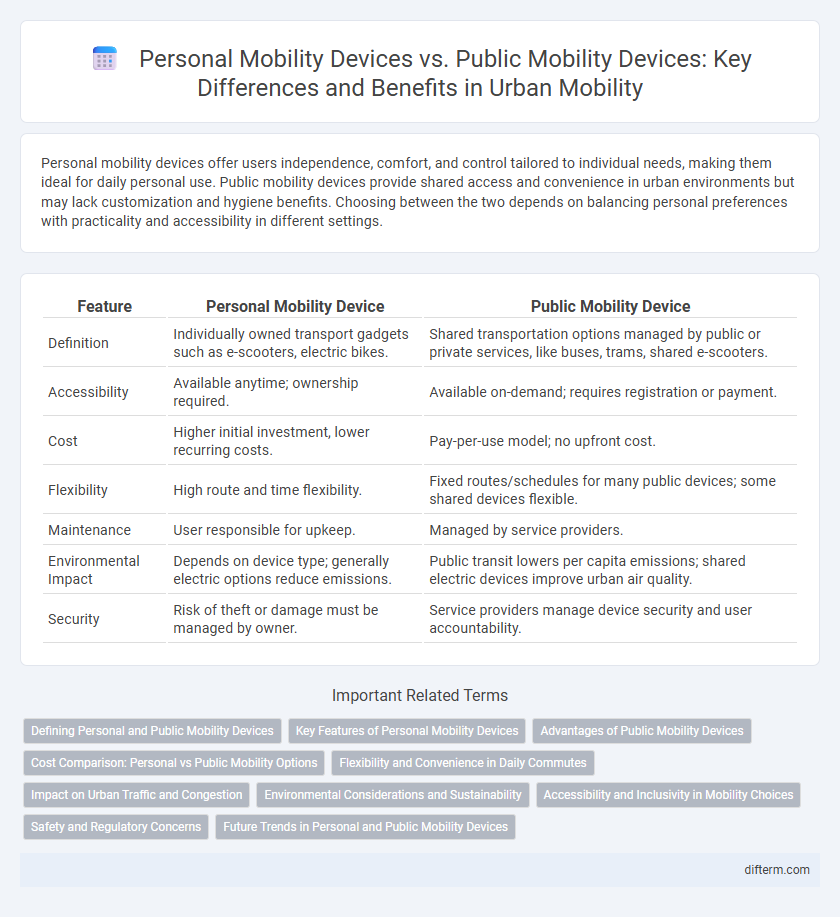Personal mobility devices offer users independence, comfort, and control tailored to individual needs, making them ideal for daily personal use. Public mobility devices provide shared access and convenience in urban environments but may lack customization and hygiene benefits. Choosing between the two depends on balancing personal preferences with practicality and accessibility in different settings.
Table of Comparison
| Feature | Personal Mobility Device | Public Mobility Device |
|---|---|---|
| Definition | Individually owned transport gadgets such as e-scooters, electric bikes. | Shared transportation options managed by public or private services, like buses, trams, shared e-scooters. |
| Accessibility | Available anytime; ownership required. | Available on-demand; requires registration or payment. |
| Cost | Higher initial investment, lower recurring costs. | Pay-per-use model; no upfront cost. |
| Flexibility | High route and time flexibility. | Fixed routes/schedules for many public devices; some shared devices flexible. |
| Maintenance | User responsible for upkeep. | Managed by service providers. |
| Environmental Impact | Depends on device type; generally electric options reduce emissions. | Public transit lowers per capita emissions; shared electric devices improve urban air quality. |
| Security | Risk of theft or damage must be managed by owner. | Service providers manage device security and user accountability. |
Defining Personal and Public Mobility Devices
Personal mobility devices, such as electric scooters and wheelchairs, are designed for individual use, providing flexibility, convenience, and accessibility tailored to the user's specific needs. Public mobility devices include shared transportation options like city bikes, e-scooters, and shared electric vehicles, intended for communal use within urban infrastructure to reduce traffic congestion and carbon emissions. Understanding the distinctions between personal and public mobility devices helps optimize urban planning and enhances sustainable transportation solutions.
Key Features of Personal Mobility Devices
Personal mobility devices offer compact design, enhanced portability, and user-centric customization, enabling seamless short-distance travel. These devices often feature rechargeable batteries, lightweight construction, and intuitive controls tailored for individual users. Unlike public mobility options, personal devices provide greater flexibility, privacy, and convenience for daily commutes and last-mile connectivity.
Advantages of Public Mobility Devices
Public mobility devices offer increased accessibility and affordability by providing shared transportation options that reduce individual ownership costs and urban congestion. These systems promote environmental sustainability through reduced emissions and energy-efficient operations compared to personal vehicles. Enhanced convenience is achieved via extensive networks and integrated technology, allowing users to easily locate and use devices for short trips without maintenance concerns.
Cost Comparison: Personal vs Public Mobility Options
Personal mobility devices such as electric scooters and bikes incur upfront costs ranging from $300 to $2,000, alongside maintenance expenses. Public mobility options, including shared scooters, bikes, and transit passes, typically involve pay-per-use fees or monthly subscriptions averaging $30 to $100. Over time, public mobility solutions offer cost-effective access without ownership burdens, while personal devices provide convenience but require higher initial investment and ongoing upkeep.
Flexibility and Convenience in Daily Commutes
Personal mobility devices such as electric scooters and bicycles offer unmatched flexibility by allowing users to customize routes and schedules, avoiding fixed transit lines and crowded stops. Public mobility devices like buses and trains provide convenience through established infrastructure and predictable service, ensuring reliable access for commuters without personal vehicle investment. In daily commutes, personal devices excel in door-to-door mobility and time-saving shortcuts, while public options support sustainability and cost-efficiency in high-density urban environments.
Impact on Urban Traffic and Congestion
Personal mobility devices such as e-scooters and electric bikes reduce urban traffic congestion by encouraging flexible, short-distance travel and decreasing reliance on cars. Public mobility devices like shared bikes and electric buses optimize space utilization and reduce vehicle emissions, contributing to smoother traffic flow. Both mobility options play complementary roles in alleviating congestion and enhancing urban transportation efficiency.
Environmental Considerations and Sustainability
Personal mobility devices, such as e-scooters and electric bikes, offer localized, low-emission transportation that reduces reliance on fossil fuels and decreases urban congestion. Public mobility devices, including shared bikes and electric buses, optimize resource use through high passenger capacity and collective usage, significantly lowering per capita carbon footprints. Integrating both types within urban transport ecosystems enhances sustainability by balancing individual convenience with environmental efficiency.
Accessibility and Inclusivity in Mobility Choices
Personal mobility devices such as electric scooters and wheelchairs offer tailored accessibility for individuals with specific mobility needs, enhancing independence and convenience in diverse environments. Public mobility devices, including buses and trains, provide inclusive transportation options designed to accommodate a broad range of users, incorporating features like ramps, priority seating, and auditory signals. Prioritizing seamless integration between personal and public mobility solutions fosters equitable access and promotes comprehensive inclusivity in urban mobility systems.
Safety and Regulatory Concerns
Personal mobility devices (PMDs) such as electric scooters and hoverboards face stringent safety regulations and require regular compliance checks to address risks like accidents and malfunctions. Public mobility devices, including shared bikes and e-scooters, are subject to municipal safety standards and liability frameworks aimed at protecting users and pedestrians in urban environments. Regulatory bodies emphasize speed limits, mandatory helmets, and maintenance protocols to mitigate safety concerns and ensure reliable operation across both device categories.
Future Trends in Personal and Public Mobility Devices
Emerging trends in personal mobility devices emphasize autonomy, lightweight materials, and enhanced battery technology, enabling greater range and convenience for urban commuters. Public mobility devices are increasingly integrated with smart city infrastructure, featuring real-time data connectivity, eco-friendly energy sources, and adaptive designs to accommodate diverse user needs. Both sectors prioritize sustainable innovation and user-centric technology to transform urban transportation landscapes by 2030.
Personal mobility device vs Public mobility device Infographic

 difterm.com
difterm.com